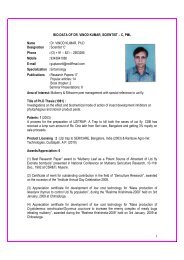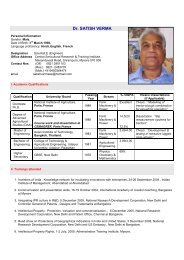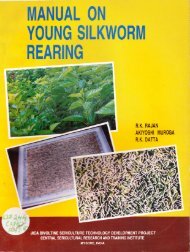Silkworm
A Treatise on the Acid Treatment of Silkworm Eggs - Central ...
A Treatise on the Acid Treatment of Silkworm Eggs - Central ...
Create successful ePaper yourself
Turn your PDF publications into a flip-book with our unique Google optimized e-Paper software.
Physiological changes in the diapuse eggs, treated with HCI after chilling<br />
Chilling (cold storing) diapause eggs at 5"C for less than 30 days is known to be insufficient to<br />
terminate diapause. However, when HCltreatment is performed on these chilled eggs, diapause termination<br />
is completely achieved. This treatment brings about the following important physio-biochemical<br />
changes.<br />
1. To begin with, the oxygen consumption increases and triggers the embryo lor an active embryo<br />
genesis.<br />
2. ln HCltreated diapause eggs (alter 30 days of chilling) the two polyols sodcitol and glycerol reconvert<br />
to glycogen. The level of glycogen increases upto 6 or 7 days of incubation with a subsequent<br />
decrease upto hatching. On the contrary, in the eggs treated with HCI after 20 hrs. of oviposition,<br />
glycogen level decreases continuously upto hatching.<br />
3. The sorbitolcontent remains unchanged on the first day and then decreases dramatically during<br />
lhe next 2 days after HCI lreatment, leaving only trace amounts.<br />
4. The NAD-SDH (NAD dependent sorlcitoldehydrogenase) activity increases rapidly reaching a<br />
maximum value seven days afterthe lreatment and then decreases untilone day before hatching.<br />
Thus there is a close correspondence between the time of the increase in NAD-SDH activity and<br />
the degradation of sorbitol during the termination of diapause.<br />
5. The activities of mitochondrialGlutamate-oxaloacetate transaminase (GOT) and malate dehydrogenase<br />
(MDH) increase in diapause eggs which are chilled at 5oC lor more than 20 days. Further,<br />
the HCI lreatment brings about an abrupt increase in the activites of mitochondrial GOT and MDH<br />
with the maximum effect appearing, two days after the treatment.<br />
The cumulative effect of these biochemical reactions ameliorales the hatching efficiency of the<br />
chilled and acid treated diapause eggs.<br />
Conclusion<br />
lnconclusion, aquestionmayarisewhetherthehotacidtreatmentisbetterorthecoldacidtreatment.<br />
Strange enough, no authentic literature is available to support the superiority of any of these methods.<br />
However, our clear answer is both. Both the methods when carried out properly have been found lo be<br />
equally elficient and are bound to give excellent resulls. The ultimate choice is thus left to the user who<br />
should take a final decision considering the following points.<br />
a. Type of eggs to be treated (purely uni/ bivoltine or mixed)<br />
b. Age of the eggs for treatment<br />
c. Season ol treatment (during summer rnonths there may be a tendency in fhe eggs to show<br />
some degree of polyvoltinism and vice versa in the winter)<br />
d. Quantity of eggs to be treated and time at lhe disposal and<br />
e. Availability of infrastructural facilities.<br />
39




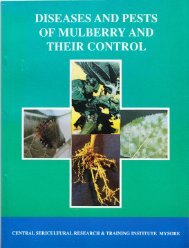

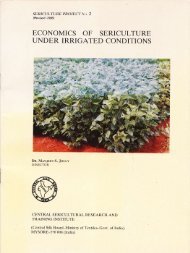
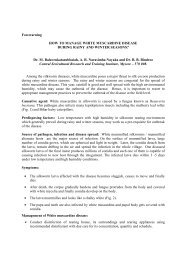
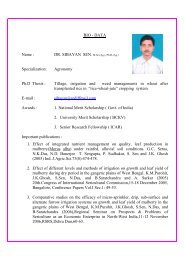
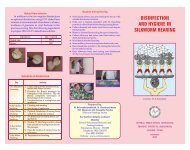
![E}A]\GALORE](https://img.yumpu.com/54052619/1/190x260/eagalore.jpg?quality=85)

